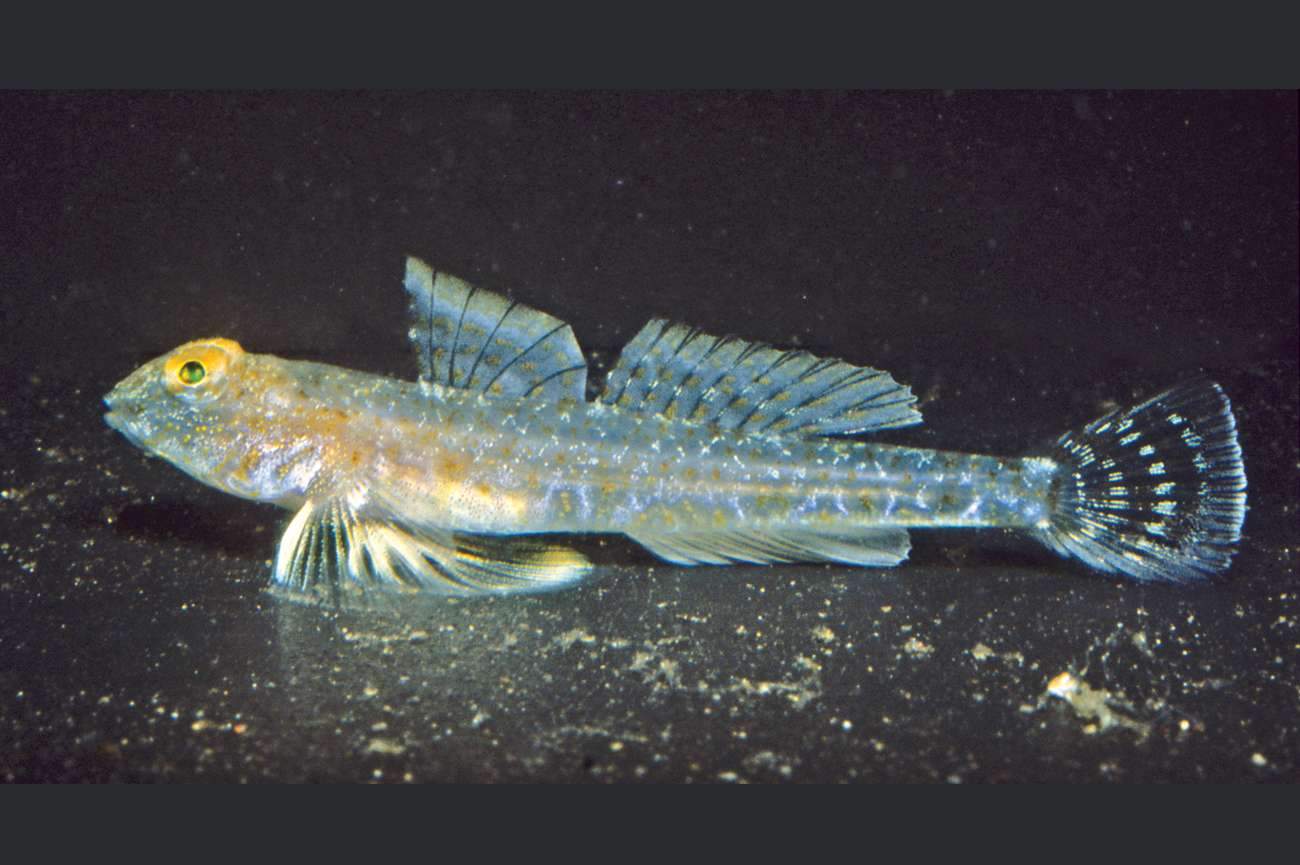- Classification
- ACTINOPTERYGII
- PERCIFORMES
- GOBIIDAE
- Nesogobius
- sp. 3 (of Hoese & Larson)
Speckled Sandgoby, Nesogobius sp. 3 (of Hoese & Larson)
Other Names: Opalescent Sandgoby

A Speckled Sandgoby, Nesogobius sp. 3. Source: Rudie H. Kuiter / Aquatic Photographics. License: All rights reserved
Summary:
A translucent to whitish sand-goby covered in many small white, brown and orange widely-spaced spots in horizontal rows on along the body, a small triangular or oval spot on the rear of the caudal peduncle, small dark brown spots in oblique rows alternating with white spots or stripes on the dorsal fins, alternating white and faint brown vertical bars on the caudal fin, 2–3 thin wavy vertical bands on the pectoral fins and an oval orange spot high on the pectoral-fin base.
Cite this page as:
Bray, D.J. 2020, Nesogobius sp. 3 (of Hoese & Larson) in Fishes of Australia, accessed 27 Jun 2025, https://fishesofaustralia.net.au/Home/species/5288
Speckled Sandgoby, Nesogobius sp. 3 (of Hoese & Larson)
More Info
|
Distribution |
Endemic to south-eastern Australia from from Bermagui, New South Wales to Port Phillip, Victoria and southern Tasmania. Inhabits pale sandy areas at depths of 2–15 m. |
|
Features |
Dorsal fin VI + 9–10; Anal fin 8–9 (rarely 8); Caudal fin (segmented rays) 13, (branched rays) 9; Pectoral fin 17–19; Pelvic fin I, 5; Gill rakers 0 + 6–7 = 6–7. Body slender. Head of moderate size (26-28% SL), broader than deep; interorbital narrow, eyes almost touching, snout convex in lateral view; mouth oblique, small, rear end of jaws below front quarter of eyes; pore by each nostril, usually no pores between eyes, one pore behind middle of each eye; one pore above rear of each preopercle; no preopercular pores; gill openings broad, reaching forward to below posterior margin of preopercles; no groove behind each posterior preopercular margin; tongue tip truncate. Head without scales; body scales ctenoid, in 22-25 vertical rows along side, scales extending forward to a line between upper pectoral fin insertions and first dorsal origin; midline of belly without scales; pectoral fin bases without scales; area before ventral fins with large cycloid scales. Two dorsal fins; first dorsal low, with rounded margin, originating above and just behind ventral fin insertions; second dorsal origin just behind first dorsal fin; anal fin origin below and just behind second dorsal origin; caudal fin short, with truncate or slightly rounded margin. Pectoral fins large, margin rounded. Pelvic fins fused to form large cup-shaped disc, originating below pectoral fin insertions, reaching to anal fin origin. |
|
Colour |
Translucent to white with many small white, brown and orange spots, brown and orange spots in horizontal rows on body; faint orange bar from eye to middle of jaws; midside with small, faint, widely separated, orange spots; rear of caudal peduncle with small, triangular or oval spot; dorsal fins with small dark brown spots in oblique rows, alternating with white spots or stripes; anal fin clear to white; caudal fin with alternating white and faint brown vertical bars; pectoral fin with 2–3 thin wavy vertical bands; oval orange spot high on pectoral-fin base; pelvic fin clear to white. |
|
Remarks |
This species is well-camouflaged to match the sandy areas on which is lives, and is rarely seen. The Speckled Sandgoby was named Nesogobius sp. 7 in Gomon et al. (1994). |
|
Author |
Bray, D.J. 2020 |
Speckled Sandgoby, Nesogobius sp. 3 (of Hoese & Larson)
References
Hoese, D.F. & Larson, H.K. 1994. Family Gobiidae. pp. 781-810, figs 690-714 in Gomon, M.F., Glover, C.J.M. & Kuiter, R.H (eds). The Fishes of Australia's South Coast. Adelaide : State Printer 992 pp. 810 figs. (as Nesogobius sp. 7)
Hoese, D.F. & Larson, H.K. 2008. Family Gobiidae. pp. 749-773 in Gomon. M.F., Bray, D.J. & Kuiter, R.H (eds). Fishes of Australia's Southern Coast. Sydney : Reed New Holland 928 pp.
-
Fish Classification
-
Class
ACTINOPTERYGII Ray-finned fishes -
Order
PERCIFORMES Perches and allies -
Family
GOBIIDAE Gobies -
Genus
Nesogobius -
Species
sp. 3 (of Hoese & Larson)


